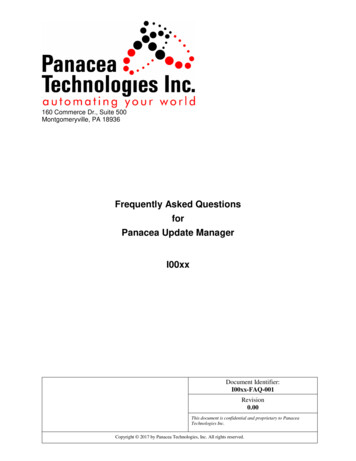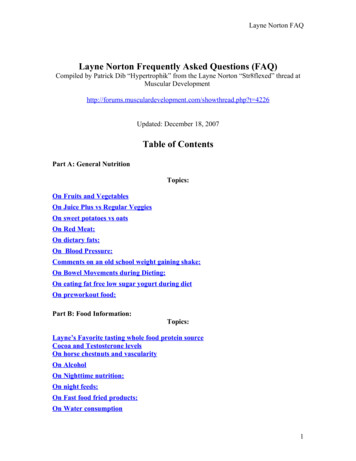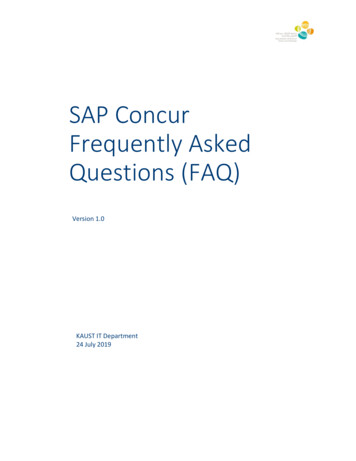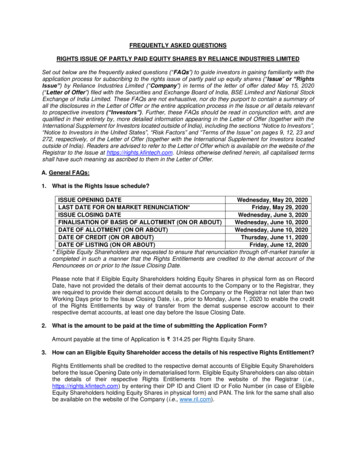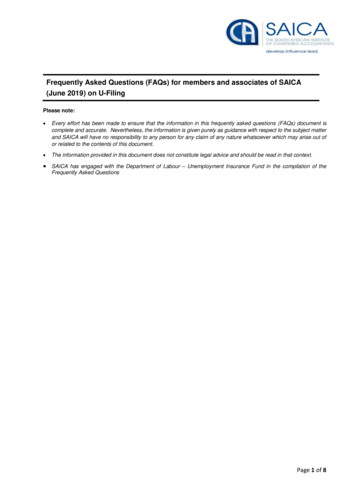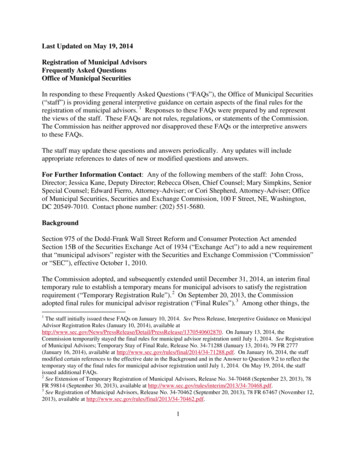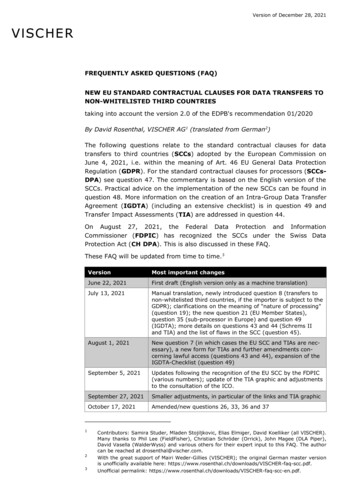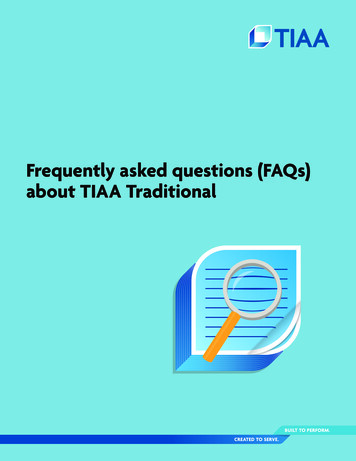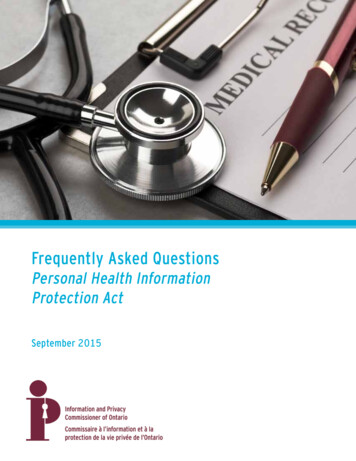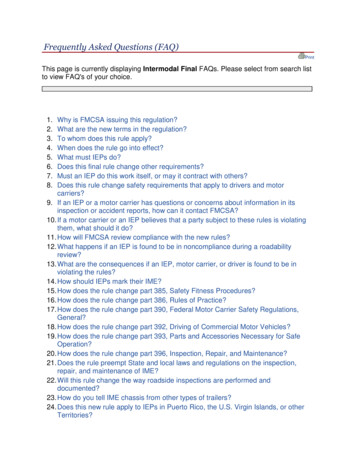
Transcription
Frequently Asked Questions (FAQ)PrintThis page is currently displaying Intermodal Final FAQs. Please select from search listto view FAQ's of your choice.1.2.3.4.5.6.7.8.Why is FMCSA issuing this regulation?What are the new terms in the regulation?To whom does this rule apply?When does the rule go into effect?What must IEPs do?Does this final rule change other requirements?Must an IEP do this work itself, or may it contract with others?Does this rule change safety requirements that apply to drivers and motorcarriers?9. If an IEP or a motor carrier has questions or concerns about information in itsinspection or accident reports, how can it contact FMCSA?10. If a motor carrier or an IEP believes that a party subject to these rules is violatingthem, what should it do?11. How will FMCSA review compliance with the new rules?12. What happens if an IEP is found to be in noncompliance during a roadabilityreview?13. What are the consequences if an IEP, motor carrier, or driver is found to be inviolating the rules?14. How should IEPs mark their IME?15. How does the rule change part 385, Safety Fitness Procedures?16. How does the rule change part 386, Rules of Practice?17. How does the rule change part 390, Federal Motor Carrier Safety Regulations,General?18. How does the rule change part 392, Driving of Commercial Motor Vehicles?19. How does the rule change part 393, Parts and Accessories Necessary for SafeOperation?20. How does the rule change part 396, Inspection, Repair, and Maintenance?21. Does the rule preempt State and local laws and regulations on the inspection,repair, and maintenance of IME?22. Will this rule change the way roadside inspections are performed anddocumented?23. How do you tell IME chassis from other types of trailers?24. Does this new rule apply to IEPs in Puerto Rico, the U.S. Virgin Islands, or otherTerritories?
25. Does an IEP located outside the United States need to mark IME that will beoperated in the United States?26. Although most foreign-based IEPs have U.S. agents, there may be cases wherethe equipment is actually owned or leased by the foreign entity. May I may I entera foreign address for the IEP on the Form MCS-150C?27. Must a driver complete a written pre-trip inspection form for intermodalequipment?28. Why does the rule refer to intermodal equipment and trailers, rather than by thecommon term "chassis?"29. If a motor carrier is transporting a van trailer that is controlled by a different motorcarrier, and the van trailer has been transported by rail during a part of aninterstate trip, is the van trailer considered intermodal equipment?30. In industry terminology, "intermodal trailer" means a closed van semi-trailer that iseither owned or controlled by a railroad, leasing company, motor carrier, or privateentities such as shippers and intermodal marketing companies. Motor carrierstransport these trailers to and from intermodal rail and marine terminals, depots,container yards, etc. Are these intermodal trailers covered by the December 2008rule?31. If an ocean carrier has a contract with a facility or terminal operator tosystematically inspect, maintain and repair the ocean carrier’s IME and to tenderthat IME to motor carriers on behalf of the ocean carrier, who is the IEP?32. In a port-wide chassis pool, ocean carriers may contract with a third-party toprovide systematic inspection, repair, and maintenance. However, each oceancarrier tenders IME directly to motor carriers. Who is the IEP?33. As a motor carrier that does not tender chassis, do violations found on the chassisimpact my Safety Measurement System scores?34. As a motor carrier that also tenders chassis, do violations found on the chassisimpact my Safety Measurement System scores?35. As an IEP-only, will my company be evaluated in the Safety MeasurementSystem?36. As an IEP-only, will my company be evaluated in the Safety Measurement Systemin the future?37. What if there is data on my record that should go against the motor carrier or IEP,how should I go about correcting this?38. As an IEP-only, will my company be subject to a review?39. As an IEP-only, will my company be issued a safety fitness rating?40. How do I determine which violations are attributed to either a motor carrier or anIEP during a roadside inspection?1. Why is FMCSA issuing this regulation?
The Federal Motor Carrier Safety Administration (FMCSA) is issuing this final ruleto implement provisions in section 4118 of the Safe, Accountable, Flexible,Efficient Transportation Equity Act: A Legacy for Users (SAFETEA-LU), applicableto “Roadability.” Section 4118 is codified in 49 U.S.C. 31151.2. What are the new terms in the regulation?Interchange means the act of providing intermodal equipment (IME) to a motorcarrier pursuant to an IME interchange agreement for the purpose of transportingthe equipment for loading or unloading by any person or repositioning theequipment for the benefit of the equipment provider. It does not include the leasingof equipment to a motor carrier for primary use in the motor carrier’s freight haulingoperations.Intermodal equipment (IME) means trailing equipment that is used in theintermodal transportation of containers over public highways in interstatecommerce, mainly chassis, but also including trailers.Intermodal equipment interchange agreement means the Uniform IntermodalInterchange and Facilities Access Agreement (UIIFA) or any other writtendocument executed by an intermodal equipment provider (IEP) or its agent and amotor carrier or its agent, the primary purpose of which is to establish theresponsibilities and liabilities of both parties with respect to the interchange of theIME.Intermodal equipment provider (IEP) means any person that interchanges IME witha motor carrier pursuant to a written interchange agreement or has a contractualresponsibility for the maintenance of the IME.3. To whom does this rule apply?The rule applies to IEPs and to motor carriers and drivers operating IME.4. When does the rule go into effect?IEPs must submit the IEP Identification Report (Form MCS-150C) and mustestablish systematic inspection, repair, and maintenance programs by December17, 2009.
IEPs must mark their IME by December 17, 2010.5. What must IEPs do?Each IEP must: Register and file using FMCSA Form MCS-150C;Mark each item of IME offered for transportation in interstate commerce with aU.S. Department of Transportation (USDOT) identification number;Establish a systematic inspection, repair, and maintenance program to assurethe safe operating condition of IME;Maintain documentation of its maintenance program; andDevelop and provide a means to effectively respond to driver and motor carrierreports about IME mechanical defects and deficiencies.6. Does this final rule change other requirements?Yes. The final rule also adds inspection requirements for motor carriers and driversoperating IME.7. Must an IEP do this work itself, or may it contract with others?An IEP may enter into agreements with others (“designated agents”) to performinspection, repair, and maintenance on its behalf. The IEP, however, is responsiblefor the work performed by its agents and for ensuring the safety of the IME ittenders to motor carriers and drivers.8. Does this rule change safety requirements that apply to drivers and motorcarriers?Yes, the safety requirements have changed: Before operating IME over the road, the driver accepting the equipment mustinspect the equipment components listed in § 392.7(b) and be satisfied that theyare in good working order; and
A driver or motor carrier transporting IME must report to the IEP, or itsdesignated agent, any known damage, defects, or deficiencies in the IME at thetime the equipment is returned to the IEP or its designated agent. If no damage,defects, or deficiencies are discovered by the driver, the report shall so indicate.The report must include, at a minimum, the items in § 396.11(a)(2).9. If an IEP or a motor carrier has questions or concerns about information inits inspection or accident reports, how can it contact FMCSA?IEPs and motor carriers may use FMCSA’s DataQ’s system to electronically filequestions or concerns at http://dataqs.fmcsa.dot.gov.10. If a motor carrier or an IEP believes that a party subject to these rules isviolating them, what should it do?The IEP, the motor carrier, or designated agent should file a complaint withFMCSA against the party believed to be in noncompliance. They should callFMCSA’s Safety Violation and Consumer Complaint Hotline is available by phoneat 1-888-DOT-SAFT or by e-mail the Hotline athttp://nccdb.fmcsa.dot.gov/HomePage.asp.11. How will FMCSA review compliance with the new rules?FMCSA will conduct roadability reviews on IEPs. A roadability review is an on-siteexamination of the IEP’s compliance with the applicable Federal Motor CarrierSafety Regulations.12. What happens if an IEP is found to be in noncompliance during a roadabilityreview?Although FMCSA will not assign a safety rating to an IEP as a result of aroadability review, it will cite the IEP for violations found and may impose civilpenalties.
13. What are the consequences if an IEP, motor carrier, or driver is found to bein violating the rules?In very general terms, consequences range from a written citation (with or withouta monetary penalty), to placing an item of IME out-of-service at roadside, toprohibiting a motor carrier from transporting IME, to prohibiting an IEP fromtendering IME.14. How should IEPs mark their IME?Each unit of IME must identify the IEP by its legal or trade name and USDOTnumber. Section 390.21(g)(4) gives an IEP four options for identifying its IME,which include: Marking the identification on the curb side of the item of equipment. Themarking must be in letters that contrast sharply in color with the background onwhich the letters are placed. The identification code must be readily legible,during daylight hours, from a distance of 50 feet (15.24 meters) while the CMVis stationary. It must be kept and maintained in a manner that retains thislegibility; orPlacing the identification marking on a label placed upon the curb side of theitem of equipment. The label must be readily visible and legible to an inspectionofficial during daylight hours when the vehicle is stationary. The label must be acolor that contrasts sharply with the background on which it is placed, and theletters must also contrast sharply in color with the background of the label. Thelabel must be kept and maintained in a manner that retains this legibility; orIncluding the USDOT number of the IEP, as well as the VIN and 4-characterSCAC code and 6-digit unique identifying number on the interchangeagreement so that it is clearly identifiable to an inspection official; orPlacing the identification information on a document placed in a weathertightcompartment affixed to the frame of the item of IME. The color of the lettersused in the document must contrast sharply in color with the background of thedocument. The document must include additional information to identify thespecific item of IME (such as the VIN and 4-character SCAC code and 6-digitunique identifying number).15. How does the rule change part 385, Safety Fitness Procedures?The final rule adds a new type of safety assessment, the roadability review. Aroadability review is an on-site examination of an IEP’s inspection, repair, and
maintenance operation and records to determine compliance with applicableFederal Motor Carrier Safety Regulations (i.e., parts 390, 393, and 396). TheAgency will conduct roadability reviews to evaluate the safety and regulatorycompliance status of IEPs.16. How does the rule change part 386, Rules of Practice?The final rule makes part 386 applicable to IEPs subject to inspection, repair, andmaintenance requirements. FMCSA has the legal authority to place IEPs out-ofservice if they tender IME that poses an imminent hazard to safety. An “imminenthazard” involves a violation of certain laws and regulations involving a “vehicle,employee, or commercial motor vehicle operations which substantially increasesthe likelihood of serious injury or death if not discontinued immediately.”17. How does the rule change part 390, Federal Motor Carrier SafetyRegulations, General?The final rule makes IEPs subject to many of the same vehicle and equipmentsafety regulations that apply to motor carriers. An IEP must: Identify its operations to the FMCSA by filing the Form MCS-150C.Mark its IME with the USDOT number, as required by § 390.21, beforetendering the equipment to a motor carrier.Systematically inspect, repair, and maintain all IME intended for interchangewith a motor carrier.Ensure that IME intended for interchange with motor carriers is in safe andproper operating condition.Maintain a system of driver vehicle inspection reports submitted to the IEP asrequired by § 396.11.Maintain a system of inspection, repair, and maintenance records for equipmentintended for interchange with a motor carrier.Periodically inspect IME intended for interchange.At facilities at which the IEP makes IME available for interchange, haveprocedures in place and provide sufficient space for drivers to perform a pre-tripinspection of tendered IME.At facilities at which the IEP makes IME available for interchange, develop andimplement procedures to repair any equipment damage, defects, or deficienciesidentified as part of a pre-trip inspection, or replace the equipment, prior to thedriver’s departure. The repairs or replacement must be made after beingnotified by a driver of such damage, defects, or deficiencies.Refrain from placing IME in service on the public highways if that equipment
has been found to pose an imminent hazard, as defined in § 386.72(b)(1).18. How does the rule change part 392, Driving of Commercial Motor Vehicles?The rule adds an inspection requirement for drivers. Drivers preparing to transportIME must make an inspection of the following components, and must be satisfiedthey are in good working order before the equipment is operated over the road.Drivers who operate the equipment over the road are deemed to have confirmedthat the following components were in good working order when the driveraccepted the equipment. Service brake components that are readily visible to a driver performing asthorough a visual inspection as possible without physically going under thevehicle, and trailer brake connections;Lighting devices and reflectors;Tires;Coupling devices;Rails or support frames;Tie down bolsters;Locking pins, clevises, clamps, or hooks; andSliders or sliding frame lock.19. How does the rule change part 393, Parts and Accessories Necessary forSafe Operation?Part 393 is revised to make it applicable to IEPs, in addition to motor carriers. Every IEP and its employees or agents responsible for the inspection, repair,and maintenance of IME interchanged to motor carriers must be knowledgeableof and comply with the applicable requirements and specifications of this part.No IEP may operate IME, or cause or permit such equipment to be operated,unless it is equipped in accordance with the requirements and specifications ofthis part.20. How does the rule change part 396, Inspection, Repair, and Maintenance?The rule revises part 396 to make it applicable to IEPs, in addition to motorcarriers. The final rule adds a new section on driver vehicle-inspection reports and
systems for reporting damage, defects, or deficiencies in the IME.21. Does the rule preempt State and local laws and regulations on theinspection, repair, and maintenance of IME?In general, yes. Any State or local law, regulation, order, or other requirement thatexceeds or is inconsistent with this regulation is preempted. However, a State withan inconsistent chassis inspection requirement in effect on January 1, 2005, mayseek a determination of non-preemption as long as its application is filed by June17, 2009. The Administrator will issue a decision within 6 months after receivingthe request. The request may be granted if the Administrator decides that the Staterequirement is just as effective as this final rule and does not unduly burdeninterstate commerce. If a State amends a regulation for which it previouslyreceived a determination of non-preemption, it must make a separate applicationfor the amended regulation. If a State does not seek a determination of nonpreemption before June 17, 2008, its inspection requirements are preempted onthat date.22. Will this rule change the way roadside inspections are performed anddocumented?The rule does not change the methods used to perform roadside inspections, but itdoes change how some information is recorded.In highway intermodal operations, different entities are usually responsible for theinspection, repair, and maintenance of the power unit (tractor) and the trailing unit(IME). In most situations, a motor carrier is responsible for the tractor, but an IEP isresponsible for the IME used to transport intermodal containers. For that reason,FMCSA has changed the Aspen software to include separate fields to record theidentification of the power unit and the trailing unit. An inspection official will enterthe USDOT numbers and equipment identification numbers for both the tractor andIME trailer.There are some motor carriers that operate their own IME. For those carriers,enter the USDOT number for the carrier in both fields, and enter the tractor andtrailer identification numbers for each unit.In some situations, motor carriers use a flatbed trailer to transport intermodalcontainers. In most cases, the flatbed trailer is not an item of IME, and it should beidentified as the motor carrier’s unit.
An intermodal container is cargo – it is not part of the IME.23. How do you tell IME chassis from other types of trailers?To tell IME from other types of trailers: Look at the lower corners. Intermodal containers transported on IME have“twistlocks” at each lower corner to secure them to the chassis.Look for the retroreflective tape. On van trailers, it is applied around the lowerperimeter of the trailer walls. On IME, the marking will be on the chassis itself,not on the container that is being transported.Look at the lower frame. Many types of IME have a large beam that runs alongtheir length. You can see this beam under the exterior floor of the container.Most types of van trailers do not have a large beam that you can see below thefloor.
Look at the information on the rear doors. Acontainer is generally marked with several items of information about thecontainer’s capacity: maximum gross weight, tare weight, net weight, and cubiccapacity. Dry van trailers are rarely marked with information at this level ofdetail.24. Does this new rule apply to IEPs in Puerto Rico, the U.S. Virgin Islands, orother Territories?The FMCSRs do not apply directly in Puerto Rico, the U.S. Virgin Islands,American Samoa, Guam, and the Northern Mariana Islands because thosejurisdictions do not fall within the definition of a "State" in 49 U.S.C. 31132(8).However, those jurisdictions are defined as "States" for purposes of the MotorCarrier Safety Assistance Program (MCSAP) [49 U.S.C. 31101(4)].Therefore, as a condition of accepting MCSAP funds, Puerto Rico, the VirginIslands, American Samoa, Guam, and the Northern Mariana Islands must adoptregulations "compatible" with 49 CFR 390-397 (see 49 CFR 350.201(a))."Compatible" means that "State laws and regulations applicable to interstatecommerce and to intrastate movement of hazardous materials are identical to theFMCSRs and the HMRs or have the same effect as the FMCSRs."An intermodal equipment provider in Puerto Rico or the U.S. Virgin Islands musttherefore comply with the "compatible" regulations those jurisdictions adopt toremain eligible for MCSAP funds. The MCSAP States (including Puerto Rico andthe U.S. Virgin Islands) may delay the adoption of compatible regulations for up tothree years after the effective date of the rule, or June 17, 2012.25. Does an IEP located outside the United States need to mark IME that will be
operated in the United States?As a practical matter, any IEP that sends chassis into the 50 States and the Districtof Columbia on or after June 17, 2009, will have to mark those chassis as requiredby the rule. Otherwise, the motor carrier pulling the chassis/container combinationwould have violated these proposed regulations.Because motor carriers are unlikely to accept the risk of fines for transportingunmarked chassis, foreign or non-‘United States’ IEPs that know their equipmentwill operate within the United States may find it necessary, for business reasons, tofile a Form MCS-150C and mark their equipment. FMCSA will accept registrationapplications from such entities and issue them USDOT numbers. In these cases,however, the assignment of an identifying number does not amount to an assertionof jurisdiction over the foreign or non-United States IEP.26. Although most foreign-based IEPs have U.S. agents, there may be caseswhere the equipment is actually owned or leased by the foreign entity. May Imay I enter a foreign address for the IEP on the Form MCS-150C?The Form MCS-150C requires a "Principal Address," which is where thecompany's safety records are maintained. FMCSA will use this address for on-sitevisits to intermodal equipment providers for the purpose of conducting roadabilityreviews. It seems likely that the records required by § 396.12 and other provisionsof the rule will be maintained near the place where intermodal equipment istendered and returned. The form also requires a "Mailing Address." This is theaddress where the company wants all its FMCSA correspondence to be sent (thismay be a P.O. Box). If an IEP wants to list a foreign address, it should use the"Mailing Address" block on the form.27. Must a driver complete a written pre-trip inspection form for intermodalequipment?Although § 390.42(b) requires drivers to advise the intermodal equipment provider(IEP) of any damage, defects, or deficiencies found during their pre-tripassessment, and § 390.40(i) requires the IEP to have procedures to repair thedeficiencies that the driver reports, the Federal Motor Carrier Safety Regulations(FMCSRs) do not require a written pre-trip inspection report.IEPs and motor carriers may use a written or electronic pre-trip inspection formthat does not conflict with the FMCSRs.
28. Why does the rule refer to intermodal equipment and trailers, rather than bythe common term "chassis?"Although the underlying legislation is concerned primarily with intermodal chassis,it used the term "intermodal equipment," which includes both trailers and chassis.We used the legislative language. Most intermodal containers are moved bychassis, but some specialized types (such as tanks in frames) could betransported on drop-deck or other trailers. If such trailers are tendered to transportintermodal containers, they are subject to the provisions of the rule.29. If a motor carrier is transporting a van trailer that is controlled by a differentmotor carrier, and the van trailer has been transported by rail during a part ofan interstate trip, is the van trailer considered intermodal equipment?No. Van trailers, flatbeds, tankers, and other types of trailers owned, leased, andmaintained by motor carriers are not intermodal equipment for purposes of this ruleand are not subject to its requirements. Motor carriers are responsible for thesystematic inspection, repair, and maintenance of these commercial motorvehicles (CMVs).30. In industry terminology, "intermodal trailer" means a closed van semi-trailerthat is either owned or controlled by a railroad, leasing company, motorcarrier, or private entities such as shippers and intermodal marketingcompanies. Motor carriers transport these trailers to and from intermodal railand marine terminals, depots, container yards, etc. Are these intermodaltrailers covered by the December 2008 rule?No. The Secretary of Transportation is required to issue regulations "to ensure thatintermodal equipment used to transport intermodal containers is safe andsystematically maintained" [49 U.S.C. 31151(a)(1), emphasis added]. Van trailersare not "intermodal containers," as that term is used in the statute.31. If an ocean carrier has a contract with a facility or terminal operator tosystematically inspect, maintain and repair the ocean carrier’s IME and totender that IME to motor carriers on behalf of the ocean carrier, who is the
IEP?If the facility or terminal operator both tenders IME and performs systematicinspection, repair, and maintenance on that equipment under contract with anocean carrier, the facility or terminal operator is the IEP.32. In a port-wide chassis pool, ocean carriers may contract with a third-party toprovide systematic inspection, repair, and maintenance. However, eachocean carrier tenders IME directly to motor carriers. Who is the IEP?An IEP, as defined in § 390.5, is ‘any person that interchanges intermodalequipment with a motor carrier pursuant to a written interchange agreement or hasa contractual responsibility for the maintenance of the intermodal equipment.’ AnIEP is required to identify itself by filing form MCS-150C, but that action, by itself,does not make it responsible for any particular piece of IME. In the case of achassis pool, the IEP may be the ocean carrier, the pool operator itself, or anotherentity that has identified itself as responsible for a given chassis. In the greatmajority of cases, the IEP will be determined by comparing the alphanumericmarking on a piece of equipment against a readily accessible electronic databasewhere IME is listed by such markings, along with the identity of the IEP currentlyresponsible for that equipment. The key concept here is the party that hasassumed responsibility for maintenance of a particular chassis; at any time, therecan be only one IEP responsible for a piece of IME.33. As a motor carrier that does not tender chassis, do violations found on thechassis impact my Safety Measurement System scores?Yes, any violation that is discovered during a roadside inspection on a chassisunder a motor carrier’s control, either by way of lease or ownership, will impact acarrier’s CSMS.34. As a motor carrier that also tenders chassis, do violations found on thechassis impact my Safety Measurement System scores?Yes, violations that are discovered during a roadside inspection on a chassis thathas been tendered by a motor carrier may impact a carrier’s CSMS. It isdependent on whether the violations found during the roadside inspection couldhave been visually and audibly detected during a driver’s pre-trip inspection and
whether the operator of the chassis conducted a pre-trip inspection.35. As an IEP-only, will my company be evaluated in the Safety MeasurementSystem?No, at this time IEPs will not be evaluated in SMS.36. As an IEP-only, will my company be evaluated in the Safety MeasurementSystem in the future?Yes, FMCSA does have plans to develop a measurement system for IEPs, muchlike we have for carriers. Therefore, violation data collected during inspectionsperformed today, may eventually be used in a measurement system for IEPs.37. What if there is data on my record that should go against the motor carrier orIEP, how should I go about correcting this?If there are violations on your record that you believe should go to another entity,you may challenge the data by going to our DataQs web site. The address ishttps://dataqs.fmcsa.dot.gov/login.asp.38. As an IEP-only, will my company be subject to a review?Yes, IEPs will be subject to roadability reviews. Roadability reviews are a review ofan IEP’s compliance with the regulations.39. As an IEP-only, will my company be issued a safety fitness rating?No, roadability reviews do not result in the assignment of a safety rating; however,if violations are found, the review may result in the issuance of civil penalties.
40. How do I determine which violations are attributed to either a motor carrieror an IEP during a roadside inspection?Go to the following link to determine if a violation is attributed to either a motorcarrier or an IEP during a roadside inspection - EP/document-library.aspx.
30. In industry terminology, "intermodal trailer" means a closed van semi-trailer that is either owned or controlled by a railroad, leasing company, motor carrier, or private entities such as shippers and intermodal marketing companies. Motor carriers transport these trailers to and from intermodal rail and marine terminals, depots,
